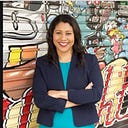What’s Next for San Francisco’s Slow Streets Program

San Francisco responded to the pandemic in incredible ways to create safe and welcoming spaces for our residents to gather. City staff, community groups, and residents came together to prioritize public health and support San Franciscans with programs during a really difficult time.
One of these programs, Slow Streets, gave people the space to get out when we needed to be healthy and advance our safety goals. The success of Slow Streets can also be seen in the way it brought communities together, especially early in the pandemic when there was a lot of fear and isolation in our neighborhoods. As a resident of this City, I’ve loved seeing the impacts that Slow Streets have on the community.
As with so many things during the pandemic, we should be proud of what we were able to do to advance this complicated program seemingly overnight. But as we move forward, we need to take a thoughtful approach to the future of this program. During the pandemic, our goal was quickly popping up temporary interventions. But now we are making decisions not for the next few months, but for years to come.
As our city begins to reopen and recover, we can no longer look at Slow Streets on a street-by-street basis. Instead, we need to look at a broader, connected network — just like our protected bike lanes in SoMa. A connected network will support people walking and biking within and between neighborhoods across the city while continuing to accommodate people driving. To accomplish this, we have to recognize that different interventions can be based on different conditions on different streets. Some streets may require traffic calming because vehicles are driving too fast. Other streets may require intersection improvements to make them easier to cross for pedestrians and wheelchair users. Still others may require reducing traffic volumes.
There is no one-size-fit-all approach, and we need to make our decisions for what makes sense based on transportation access, safety improvements, maximizing mobility for all users, and advancing our goals to reduce our greenhouse gas emissions. The purpose of the network will be to provide safe routes for everyone in the city to get around, and not solely to provide exclusive routes or turning public streets into private streets for local residents.
There are challenges with the Slow Streets program and how people feel about it. People’s concerns are real and should be heard. Take Lake Street, for example. Lake Street has experienced a heightened level of controversy. There is strong disagreement there amongst the residents about what the future of that street should be.
I have met with groups on both sides of the Lake Street debate — those wanting the street to return to its pre-pandemic state and those wanting the thru-vehicle restrictions to continue permanently. Along with SFMTA, we have worked for months to encourage dialogue, compromise, and hopefully mutual understanding. Ultimately, we want to bring neighbors together, not see this program continue to divide. While we need to make decisions based on what makes sense from a transportation, safety, and climate change perspective, we must also genuinely consider neighborhood feedback.
Regardless of where we end up on Lake Street, the overall Slow Streets Program needs work and needs to evolve. In September, the SFMTA Board will consider the future of the Slow Streets Program. Some streets that were included in the pandemic response make sense and others do not. And other streets that were left off the table should be considered for new interventions. While there has been strong advocacy for certain streets, we see that the advocacy is often focused on affluent areas, and certain lower income communities and what they want are left behind. We need to change that. And as I said earlier, we need to think about the entire network, and move away from operating on a street-by-street basis.
I know there are strong feelings about Slow Streets. And debate can be healthy and constructive. But it’s important that we take in the whole citywide picture, listen thoughtfully to everyone, and develop a real connected network that allows people and families to get around our entire City using different modes of transportation safely and efficiently.
